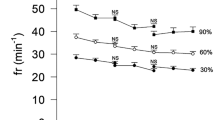Summary
The paper concerns a longitudinal study of the relationship between growth in lung functions in terms of forced vital capacity and forced expiratory volume in 1s, and the development of maximal aerobic power during the age span from 8–18 years of age.
The growth curves of anatomical dimensions for boys and girls were similar to those previously established for Northern European children. The growth in lung volume ended later than the growth in body height.
It was found that the growth in lung volume was entirely due to growth in body dimensions, with no additional effect of changes in the development of physical performance capacity.
Similar content being viewed by others
References
åstrand P-O (1952) Experimental studies of physical working capacity in relation to sex and age. Ejnar Munksgaard, Copenhagen
Cotes JE, Anderson HR, Patrick JM (1974) Lung function and the response to exercise in New Guineans; role of genetic and environmental factors. Philos Trans R Soc Lond [Biol] 268: 349–361
Döbeln W von, Eriksson BO (1972) Physical training, maximal oxygen uptake and dimensions of the oxygen transporting and metabolizing organs in boys 11–13 years of age. Acta Paediatr Scand 61: 653–660
Engström I, Eriksson BO, Karlberg P, Saltin B, Thorén C (1971) Preliminary report on the development of lung volumes in young girl swimmers. Acta Paediatr Scand [Suppl] 217: 73–76
Eriksson BO, Engström I, Karlberg P, Saltin B, Thorén C (1978) Long-term effect of previous swimtraining in girls. A 10-year follow-up of the ‘girl swimmers’. Acta Paediatr Scand 67: 285–292
Koch G (1980) Aerobic power, lung dimensions, ventilatory capacity and muscle blood flow in 12–16-year-old boys with high physical activity. In: Berg K, Eriksson BO (eds) Children and exercise IX. Int Ser on Sport Sci, vol 10. University Park Press, Baltimore, pp 99–108
Lange Andersen K, Magel JR (1970) Physiological adaptation to a high level of habitual physical activity during adolescence. Int Z Angew Physiol 28: 209–227
Lange Andersen K, Seliger V, Rutenfranz J, Mocellin R (1974) Physical performance capacity of children in Norway. Part I. Population parameters in a rural inland community with regard to maximal aerobic power. Eur J Appl Physiol 33: 177–195
Polgar G, Promadhat V (1971) Pulmonary function testing in children: Techniques and standards. Saunders, Philadelphia London Toronto
Rutenfranz J, Lange Andersen K, Seliger V, Klimmer F, Berndt I, Ruppel M (1981) Maximum aerobic power and body composition during the puberty growth period: Similarities and differences between children of two European countries. Eur J Pediatr 136: 123–133
Strang LB (1959) The ventilatory capacity of normal children. Thorax 14: 305–310
Tanner JM (1962) Growth at adolescence. Blackwell Scientific Publications, Oxford
Weber G, Kartodihardjo W, Klissouras V (1976) Growth and physical training with reference to heridity. J Appl Physiol 40: 211–215
Author information
Authors and Affiliations
Rights and permissions
About this article
Cite this article
Andersen, K.L., Rutenfranz, J., Seliger, V. et al. The growth of lung volumes affected by physical performance capacity in boys and girls during childhood and adolescence. Europ. J. Appl. Physiol. 52, 380–384 (1984). https://doi.org/10.1007/BF00943367
Accepted:
Issue Date:
DOI: https://doi.org/10.1007/BF00943367




